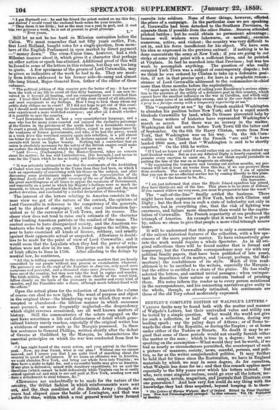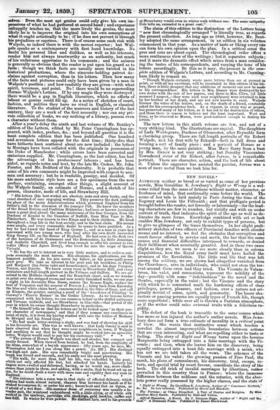BENTLEY'S COMPLETE EDITION OF WALPOLE'S LETTERS.* VARIOUS faults may be
found both with the matter and manner of Walpole's Letters, but their unrivalled value and utility can be tested by a simple question. What would the world not give for such a collection, or half of such a collection, during any leading epoch; say the palmy days of Athens ; or of Rome to- wards the close of the Republic, or during the Empire ; or at home under either of the Tudors or Stuarts. No doubt it may be ar- gued that some of these periods would not exactly furnish either the matter or the man ; which is true in a degree ; but we are speaking on the assumption—What would they not be worth, if we had as nearly as circumstances permitted, the counterpart of such a picture of manners, society, news, scandal, persons, and poli- tics, so far as the writer comprehended politics. It may further be held that for times since the Restoration, we have in England materials by which we may in some degree, do for ourselves, what Walpole has done for us ; and that this remark applies more especially to the fifty years over which his letters extend. But who, save some singular recluse, could go over all the letters, me- moirs, essays, novels magazines, and journals that illustrate even one generation? And how very few could do any thing with the knowledge they had thus acquired, beyond keeping it to them- • The Letters of Ho-race Walpole, Sart of Orford. Edited by Peter Cunning- ham. Now first Chronologically arranged. In nine volumes. Vol. IL Published by Bentley. wives. Even the most apt genius could only give his own im- pressions of what he had gathered at second hand ; and experience unhappily teaches us, that the more lively the genius, the more likely he is to improve the original into his own conceptions of what it ought artistically to be ; if he does not pervert it through his prejudices or caprices. There is of course some such risk with Walpole' as indeed there is with the merest reporter; but Wal- pole speaks as a contemporary with first hand knowledge. No doubt his personal likes and dislikes, as well as his interests, render him not always trustworthy as an authority, but much of his unfairness appertains to his comments ; and the animus is generally so obvious that the reader is put upon his guard as to facts ; though we think facts are usually more twisted in his historical productions, where the sinecure-holding patriot de- claims against corruption, than in his letters. Then how many of the facts and pictures could only have been given by a man in Walpole's position ; and how readably they are given—with what spirit, terseness, and point. No! there would be no superseding Horace Walpole's Letters. If by any magic they were destroyed ; there would be a gap in English literature, which no efforts of labour or genius could fill up. As a series of sketches of court, fashion, and politics they have no rival in English, or classical literature. To the student of the manners and history of the last century, they are a work of the first necessity ; nor can any pri- vate collection of books, we say nothing of a library, possess even a character without them.
After a year's delay the ninth and last volume of Mr. Bentley's edition of the Letters, edited by Mr. Peter Cunningham has ap-
peared, with index, preface, ; and beyond all question it is the most complete edition that has been published. One hundred and seventeen letters appear for the first time ; thirty-five that have hitherto been scattered about are now included ; the letters to Montagu have been collated with the originals in possession of the Duke of Manchester ; while errors have been corrected and omissions supplied. Mr. Cunningham, as the last editor, has had the advantage of his predecessors' labours ; and has been aided, as regards notes and text, by the late Mr. Croker, Mr. John Forster, and Mr. Bedford of the Admiralty. It is probable that some of his own comments might be improved with respect to acu- men and accuracy; but he is readable, gossipy, and decided. Of his more ambitious style here are a few specimens from the new preface, containing, amongst other things, a slight account of the Walpole family, an estimate of Horace, and a sketch of his person, character, mode of life, and Strawberry Hill.
"His letters (his best works) are absolute jests and story books, and the exact standaid of easy engaging writing. They preserve the dark jostlings for place of the many Administrations which governed England from his father's fall to the accession of the younger Pitt. He knew the members of the Broad Bottom and Coalition Ministries ; had'seen or known (certainly knew a great deal about) the many mistresses of the four Georges, from the Duchess of Kendal to the Countess of Suffolk, from Miss Vane to Mrs. Fitzherbert. He was known to two Kings and to their children. He lived throughout a long life in the best society, and in the best clubs. His means were ample, and every reasonable desire he seems to have gratified. As a boy he had kissed the band of King George I., and as a man in years had conversed with two young men, who long after his own death succeeded King George III. on the throne of England. He had seen in the flesh two of the heroines of de Grammont and the Restoration, La Belle Jennings, and Arabella Churchill, and lived long enough to offer his coronet to two ladies(Mary and Agnes Berry), who lived far into the reign of Queen Victoria.
"He has the art to interest us in very little matters, and to enliven sub- jects seemingly the most barren. His allusions, his applications, are the happiest possible. As his pen never lay fallow, so his goose-quill never grew grey. We take an interest in his gout and his bootikins, in Philip and Margaret (his Swiss valet and housekeeper), and in his dogs Patapan, Tonton, and Rosette. We know every room in Strawberry Hill, and every miniature and full-length portrait in the Tribune and Gallery. We are ad- mitted to the Holbein chamber and the Beauclerk closet, and as we wander in print over the stripped rooms and now newly furnished walls, we can pass a night in his favourite Blue Room restore the Roman Eagle, replace the bust of Vespasian and the armour of Francis I.; bring back from Knowsley the blue and white china bowl, commemorated in the Odes of Gray, and call up Kirgate, the printer, carrying a proof of the Anecdotes of Painting' to Conway's Elzevir Horace' in the Gothic Library. As we become better acquainted with his letters, we can summon before us the skilful antiquary and Virtuoso midwife, and see Strawberry in lilac-tide—that period of the year in which its owner thought Strawberry in perfection.
"Ho himself tells us that his letters are to be looked upon in their pro- per character of newspapers,' and that if they possess any excellence in point of style, it is from his having studied with care the letters of Madame de Sevigne and his friend Gray." • • "He had made letter-writing a study, and was fond of showing his skill in his favourite art. This was so well known : that Lady Ossory is said to have observed that when they were near neighbours in town, if Walpole had anything to say that he thought might be worked into an agreeable letter, 'Walpole would omit to pay her his customary visit." • • • "The person of Horace Walpole was short and slender, but compact and neatly formed. When viewed from behind, he had, from the simplicity of his dress, somewhat of a boyish appearance : fifty years ago, he says Mr. Winnington told me I ran along like a pewet. (ix. 337.) His forehead was high and pale. His eyes remarkably bright and penetrating. His laugh was forced and uncouth, and his smile not the most pleasing.
"His walk, for more than half his life, was enfeebled by the gout; which not only affected his feet, but attacked his hands. Latterly his fingers were swelled and deformed, having, as he would say, more chalk- stones than joints in them, and adding, with a smile, that he must set up an inn, for he could chalk a score with more ease and rapidity that any man in England.
His entrance into a room was in that style of affected delicacy, which fashion had made almost natural, chapeau bras between his hands as if he wished to compress it, or under his arm ; knees bent and feet on tiptoe, as if afraid of a wet floor. His summer dress of ceremony was usually a la- vender suit, the waistcoat embroidered with a little silver, or of white silk worked in the tambour, partridge silk stockings, gold buckles, ruffles and lase frill. In winter he wore powder. He disliked hats, and in his grounds at Strawberry would even in winter walk without one. The same antipathy
Cole tells us, extended to a great coat." ,
The claim of this edition to the distinction of the Letters being "now first chronologically arranged" is literally true, as
the present collection. As long ago as 1840, however, Mr. nt- ley adopted the same arrangement, in an edition in six volumes commenced in that year. As a matter of taste or liking every one can form his own opinion upon the plan. In a critical sense the pros and cons are about equal. The chronological order offers a more continuous view of the writings ; but it separates subjects ; and it mars the dramatic effect which arises from a man consider- ing the tastes of his correspondents, and varying the tone of his letters accordingly. Be this as it may, the present is the cons- piste edition of Walpole's Letters, and according to Mr. Cunning- ham likely to remain so. "Though Walpole certainly wrote more letters than are at present in print, or with all my exertions' will be ineuluded in this edition of his let- ters, there is little prospect that any additions of moment can now be made to his correspondence. His letters to Mrs. Darner were destroyed by her own desire with the rest of her papers, and those to Mrs. Clive, (of little moment I suspect,—they were such near neighbours) were returned to him by her brother at her death, and are not now known to exist. Walpole foresaw the value of his letters and, on the death of a friend, constantly asked for his correspondence back. As a request, in every way so proper, has preserved many of his letters, so it has led to the destruction of others, and those there is reason to believe not the least important. West avid Gray, as he observed to Mason, were good-natured enough to destroy his letters."
The new letters in this ninth volume are few, and not of a very striking kind. The illustrations are capital. The daughters of Lady Waldegrave, Duchess of Gloucester, after Reynolds form a charming group. There are full length portraits of Sir Robert Walpole, and his first wife by Eckardt—both in full dress and forming a sort of family piece ; and a portrait of Horace as a young man, by the same painter. Miss Mary Berry from a bust by Mrs. Darner is not very striking ; but Dorothy Viscountess Townshend sister of Sir Robert, after Jervas, is a remarkable portrait. There are character, action and the look of life about rt. Unless the engraver has assisted the painter, Jervas was a man of more metal than we took him for.































 Previous page
Previous page